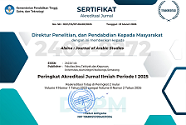Penggunaan Metode Ganjaran dalam Meningkatkan Motivasi Belajar Bahasa Arab
DOI:
https://doi.org/10.21580/alsina.1.1.1459Keywords:
Metode pembelajaran, motivasi belajar, Mas Bahrul HikmahAbstract
This study aims to reveal descriptively about the use of learning methods in improving students' learning motivation in Mas Bahrul Hikmah Konawe North Sultra to find out what methods are applied during the learning process at Mas Bahrul Hikmah Konawe Utara and to find out how the motivation of student learning Mas Bahrul Hikmah Konawe North. The method used in this research is descriptive qualitative method in order to give explanation about the use of learning method in improving students' learning motivation Arabic in Mas Bahrul Hikmah Konawe Utara Sultra. The data obtained through interviews with informants research related to the achievement of the purposes of research. Subjects in this study were teachers and students at Mas Bahrul Hikmah Konawe Utara Sultra. The result of the research are: (1) The method applied when the learning process of Arabic language in Mas Bahrul Hikmah is, conversation method or muhadatsah, the method of reading that is qira'ah (muthala'ah), grammatical method or qowa'id (al-kitabah) and Listening method (al-istima'i) this method is commonly used when imla learning process, besides using special method of learning Arabic language also using general methods, such as lecture method, discussion method, group work method, question and answer method and method Assignment. There is also a new method addition, reward method. The reward method applied is the method of punishment and reward method. (2) The use of reward method in Mas Bahrul Hikmah is very effective besides can grow student's motivation in learning also help student get high test value, because after use method of reward value of student exam much increase.
Downloads
References
Anshor Ahmad Muhtadi. 2009. Pengajaran Bahasa Arab, Media dan Metode-Metodenya. Yogyakarta: Teras.
Thobroni Muhammad, Arif Mustofa. 2011. Belajar dan pembelajaran. Yogyakarta: Ar-Ruzz Media.
Iskadarwassid, Dadang Sunendar. 2013. Strategi Pembelajaran Bahasa. Bandung: Pt Remaja Rosdakarya Offset.
Effendy Ahmad Fuad. 2012. Metodologi Pengajaran Bahasa Arab. Malang: Misykat.
Faisal Sanafiah. 2001. Metodologi Penelitian Sosial. Jakarta: Erlangga.
Hamruni. 2009. Strategi dan Model-Model Pembelajaran Aktif Menyenangkan. Yogyakarta: Fakultas Tarbiyah UIN Sunan Kalijaga Yogyakarta.
Hermawan Acep. 2011. Metodologi Pembelajaran Bahasa Arab. Bandung: PT Remaja Rosdakarya.
Huda Miftahul. 2003. Model-Model Pengajaran dan Pembelajaran. Yogyakarta: Pustaka Pelajar Offset.
Izzan Ahmad. 2009. Metodologi Pembelajaran Bahasa Arab. Bandung: Humaniora.
Madjid Nurcholish. 2003. Bahasa Arab dan Metode Pengajarannya. Yogyakarta: Pustaka Pelajar.
Muna Wa. 2011. Metodologi Pembelajaran Bahasa Arab. Yogyakarta: Teras.
Mujib Fathul, Nailur Rahmawati. 2011. Metode Permainan-Permainan Edukatif Dalam Belajar Bahasa Arab. Yogyakarta: Diva Press.
Nasution. 1995. Didaktik Asas-Asas Mengajar. Jakarta: Bumi Aksara.
Nuha Ulin. 2012. Metodologi Super Efektif Pembelajaran Bahasa Arab. Yogyakarta: Diva Press.
Sardiman. 2010. Interaksi dan Motivasi Belajar Mengajar. Rajawali Pers.
Sugiono. 2011. Metode Penelitian Kuantitatif Kualitatif dan R&D. Bandung: Alfabeta.
Suja’i. 2008. Inovasi Pembelajaran Bahasa Arab. Semarang: Walisongo Press.
S.P. Hasibuan Melayu. 1996. Organisasi dan Motivasi Dasar Peningkatan Produktivitas. Jakarta: Bumi Aksara.
Downloads
Additional Files
Published
How to Cite
Issue
Section
License
Copyright
The copyright of the received article shall be assigned to the publisher of the journal. The intended copyright includes the right to publish the article in various forms (including reprints). The journal maintains the publishing rights to published articles. Authors are allowed to use their articles for any legal purposes deemed necessary without written permission from the journal, but with an acknowledgment to this journal of initial publication.
Licensing
In order for Alsina: Journal of Arabic Studies to publish and distribute research articles, the editors need publishing rights (transferred from author to publisher). This agreement relates to the transfer/publishing copyright license to Alsina: Journal of Arabic Studies but the authors still have significant rights to use and share their published articles.
Alsina: Journal of Arabic Studies supports the need for writers to share, disseminate and maximize the impact of their research and their rights on any database. As a journal article writer, you have the right to various uses of your articles, including that by the institution or company where you work. Copyright can be used without the need for special permission. Authors who publish articles in the Alsina: Journal of Arabic Studies have broad rights to use their work for teaching and scientific purposes without requesting permission, including:
- Use by the author for lectures, presentations, or conferences, with distribution of copies to participants;
- Distribution to colleagues for research use;
- Use in compilations of the author's subsequent work;
- inclusion in a thesis or dissertation;
- Reuse of sections or excerpts from articles in other works (with full acknowledgment of the final article);
- Preparation of derivative works (other than commercial purposes) (with full acknowledgment of the final article);
- Voluntary posting on open websites operated by authors’ or writers' agencies for scientific purposes
When submitting a manuscript, authors do so on the understanding that if accepted for publication, the copyright for publishing (publishing right) of the article shall be assigned/transferred to Alsina: Journal of Arabic Studies.
Authors whose articles are accepted for publication will receive confirmation via email and sent a Copyright Transfer Agreement.


 Accreditation
Accreditation 
 In Collaboration with
In Collaboration with 

 Visitors
Visitors  Article Template
Article Template





